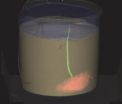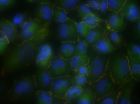(Press-News.org) Composite materials used in aircraft wings and fuselages are typically manufactured in large, industrial-sized ovens: Multiple polymer layers are blasted with temperatures up to 750 degrees Fahrenheit, and solidified to form a solid, resilient material. Using this approach, considerable energy is required first to heat the oven, then the gas around it, and finally the actual composite.
Aerospace engineers at MIT have now developed a carbon nanotube (CNT) film that can heat and solidify a composite without the need for massive ovens. When connected to an electrical power source, and wrapped over a multilayer polymer composite, the heated film stimulates the polymer to solidify.
The group tested the film on a common carbon-fiber material used in aircraft components, and found that the film created a composite as strong as that manufactured in conventional ovens -- while using only 1 percent of the energy.
The new "out-of-oven" approach may offer a more direct, energy-saving method for manufacturing virtually any industrial composite, says Brian L. Wardle, an associate professor of aeronautics and astronautics at MIT.
"Typically, if you're going to cook a fuselage for an Airbus A350 or Boeing 787, you've got about a four-story oven that's tens of millions of dollars in infrastructure that you don't need," Wardle says. "Our technique puts the heat where it is needed, in direct contact with the part being assembled. Think of it as a self-heating pizza. ... Instead of an oven, you just plug the pizza into the wall and it cooks itself."
Wardle says the carbon nanotube film is also incredibly lightweight: After it has fused the underlying polymer layers, the film itself -- a fraction of a human hair's diameter -- meshes with the composite, adding negligible weight.
The team, including MIT graduate students Jeonyoon Lee and Itai Stein and Seth Kessler of the Metis Design Corporation, has published its results in the journal ACS Applied Materials and Interfaces.
Carbon nanotube deicers
Wardle and his colleagues have experimented with CNT films in recent years, mainly for deicing airplane wings. The team recognized that in addition to their negligible weight, carbon nanotubes heat efficiently when exposed to an electric current.
The group first developed a technique to create a film of aligned carbon nanotubes composed of tiny tubes of crystalline carbon, standing upright like trees in a forest. The researchers used a rod to roll the "forest" flat, creating a dense film of aligned carbon nanotubes.
In experiments, Wardle and his team integrated the film into airplane wings via conventional, oven-based curing methods, showing that when voltage was applied, the film generated heat, preventing ice from forming.
The deicing tests inspired a question: If the CNT film could generate heat, why not use it to make the composite itself?
How hot can you go?
In initial experiments, the researchers investigated the film's potential to fuse two types of aerospace-grade composite typically used in aircraft wings and fuselages. Normally the material, composed of about 16 layers, is solidified, or cross-linked, in a high-temperature industrial oven.
The researchers manufactured a CNT film about the size of a Post-It note, and placed the film over a square of Cycom 5320-1. They connected electrodes to the film, then applied a current to heat both the film and the underlying polymer in the Cycom composite layers.
The team measured the energy required to solidify, or cross-link, the polymer and carbon fiber layers, finding that the CNT film used one-hundredth the electricity required for traditional oven-based methods to cure the composite. Both methods generated composites with similar properties, such as cross-linking density.
Wardle says the results pushed the group to test the CNT film further: As different composites require different temperatures in order to fuse, the researchers looked to see whether the CNT film could, quite literally, take the heat.
"At some point, heaters fry out," Wardle says. "They oxidize, or have different ways in which they fail. What we wanted to see was how hot could this material go."
To do this, the group tested the film's ability to generate higher and higher temperatures, and found it topped out at over 1,000 F. In comparison, some of the highest-temperature aerospace polymers require temperatures up to 750 F in order to solidify.
"We can process at those temperatures, which means there's no composite we can't process," Wardle says. "This really opens up all polymeric materials to this technology."
The team is working with industrial partners to find ways to scale up the technology to manufacture composites large enough to make airplane fuselages and wings.
"There needs to be some thought given to electroding, and how you're going to actually make the electrical contact efficiently over very large areas," Wardle says. "You'd need much less power than you are currently putting into your oven. I don't think it's a challenge, but it has to be done."
INFORMATION:
This research was funded in part by Airbus Group, Boeing, Embraer, Lockheed Martin, Saab AB, TohoTenax, ANSYS Inc., the Air Force Research Laboratory at Wright-Patterson Air Force Base, and the U.S. Army Research Office.
WASHINGTON, DC - April 14, 2015 - A new study has demonstrated that genetically modified Salmonella can be used to kill cancer cells. The study is published in this week's issue of mBio, an American Society for Microbiology online-only, open access journal.
"There has long been interest in using genetically engineered microbes to target and destroy cells within solid tumors. I think this study goes a significant way in developing some strategies that will help in the overall means of using Salmonella as part of a cancer therapy," said Roy Curtiss, III, PhD, who was involved ...
LOS ANGELES (EMBARGOED UNTIL 7 A.M. EDT on APRIL 14, 2015) - An injection of stem cells into the eye may soon slow or reverse the effects of early-stage age-related macular degeneration, according to new research from scientists at Cedars-Sinai. Currently, there is no treatment that slows the progression of the disease, which is the leading cause of vision loss in people over 65.
"This is the first study to show preservation of vision after a single injection of adult-derived human cells into a rat model with age-related macular degeneration," said Shaomei Wang, MD, ...
Scientists at the University of Southampton have shown that higher muscle mass is strongly linked with healthier bone development in children.
Researchers also found no relationship between fat mass and bone development, indicating it is not an important factor in childhood skeletal strength.
A new study, published in the journal Bone, by researchers from the University's Medical Research Council Lifecourse Epidemiology Unit shows a link between the amount of lean muscle and healthy bone development, indicated by the size, shape and density of limb bones, in children ...
Methane, a highly effective greenhouse gas, is usually produced by decomposition of organic material, a complex process involving bacteria and microbes.
But there is another type of methane that can appear under specific circumstances: Abiotic methane is formed by chemical reactions in the oceanic crust beneath the seafloor.
New findings show that deep water gas hydrates, icy substances in the sediments that trap huge amounts of the methane, can be a reservoir for abiotic methane. One such reservoir was recently discovered on the ultraslow spreading Knipovich ridge, ...
Researchers at Uppsala University have, together with researchers from Turku and Bergen, discovered a new biomarker which makes it possible to identify women with uterine cancer who have a high risk of recurrence. The findings were recently published in the journal Gynecologic Oncology.
Endometrial cancer of the uterus is the most common form of gynecologic cancer in Europe and North America. The treatment primarily consists of removing the uterus and in some cases offering chemotherapy if the risk of recurrence is deemed high.
The current study looks at the amount ...
Researchers at the University of Manchester and Central Manchester University Hospitals NHS Foundation Trust have published data for the first time about public knowledge of and interest in the process of medicines research and development.
The study, which is part of the wider European Patients' Academy on Therapeutic Innovation (EUPATI) project, is believed to be the largest peer-reviewed survey of its kind and was published today in the BMJ Open.
Medicines R&D describes the entire process of bringing a new medicine to patients - from laboratory studies to clinical ...
The seabed is inhabited by vast numbers of small animals with hidden lives in the sandy sediments. Here they play an important role in keeping the oceans healthy. But how these animals behave and interact with each other is unclear, as it is not possible to see them without disturbing the sediment.
Researchers like Ph.D. Matthieu Delefosse would enjoy putting on a pair of X-ray glasses and study the sediment living animals without disturbing them.
"We know bits and pieces of what these animals do through different measurements/experiments, but we do not have an integrated ...
Researchers at Genes and Cancer group at Bellvitge Biomedical Research Institute (IDIBELL), led by Montse Sanchez-Cespedes, have identified the PARD3 gene as a tumor suppressor that is inactivated in lung cancer squamous type. The results of the study have been published in Cancer Research.
Correct polarization (orientation in space) of bronchial epithelial cells is essential for the maintenance and proper development of this tissue under normal conditions.
PARD3 gene encodes a protein that regulates cell polarization and cell junctions. When the gene is inactivated, ...
Scientists at the University of Sheffield calculate that all of the UK's high level nuclear waste from spent fuel reprocessing could be disposed of in just six boreholes 5km deep, fitting within a site no larger than a football pitch.
The concept - called deep borehole disposal - has been developed primarily in the UK but is likely to see its first field trials in the USA next year. If the trials are successful, the USA hopes to dispose of its 'hottest' and most radioactive waste - left over from plutonium production and currently stored at Hanford in Washington State ...
Simply declaring a region as a nature protection area is not enough, regular monitoring of its ecological condition is also necessary. Since Nature protection areas already cover almost one fifth of the surface of the European Union, it is impossible to inspect such a vast area in the traditional way on foot. Therefore, new methods are being developed to monitor Europe's nature protection areas from the air. Short laser pulses are sent to the ground, and information on the status of the habitat can be deduced from the reflected light signals using elaborate computer algorithms.
Laser ...



